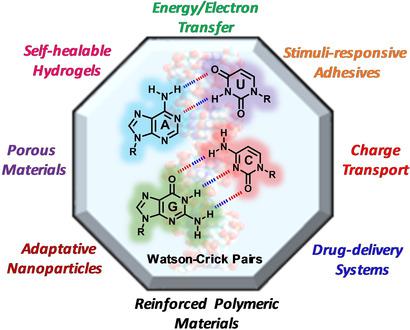当前位置:
X-MOL 学术
›
Chemistryopen
›
论文详情
Our official English website, www.x-mol.net, welcomes your
feedback! (Note: you will need to create a separate account there.)
Functional Systems Derived from Nucleobase Self‐assembly
ChemistryOpen ( IF 2.5 ) Pub Date : 2020-04-01 , DOI: 10.1002/open.201900363 Anselmo Del Prado 1 , David González-Rodríguez 1, 2 , Yi-Lin Wu 3
ChemistryOpen ( IF 2.5 ) Pub Date : 2020-04-01 , DOI: 10.1002/open.201900363 Anselmo Del Prado 1 , David González-Rodríguez 1, 2 , Yi-Lin Wu 3
Affiliation

|
Dynamic and reversible non‐covalent interactions endow synthetic systems and materials with smart adaptive functions that allow them to response to diverse stimuli, interact with external agents, or repair structural defects. Inspired by the outstanding performance and selectivity of DNA in living systems, scientists are increasingly employing Watson−Crick nucleobase pairing to control the structure and properties of self‐assembled materials. Two sets of complementary purine‐pyrimidine pairs (guanine:cytosine and adenine:thymine(uracil)) are available that provide selective and directional H‐bonding interactions, present multiple metal‐coordination sites, and exhibit rich redox chemistry. In this review, we highlight several recent examples that profit from these features and employ nucleobase interactions in functional systems and materials, covering the fields of energy/electron transfer, charge transport, adaptive nanoparticles, porous materials, macromolecule self‐assembly, or polymeric materials with adhesive or self‐healing ability.
中文翻译:

核碱基自组装衍生的功能系统
动态和可逆的非共价相互作用赋予合成系统和材料智能的适应功能,使它们能够响应不同的刺激,与外部介质相互作用,或修复结构缺陷。受到生命系统中 DNA 的出色性能和选择性的启发,科学家们越来越多地采用 Watson-Crick 核碱基配对来控制自组装材料的结构和特性。两组互补的嘌呤-嘧啶对(鸟嘌呤:胞嘧啶和腺嘌呤:胸腺嘧啶(尿嘧啶))可提供选择性和定向的氢键相互作用,呈现多个金属配位位点,并表现出丰富的氧化还原化学。在这篇综述中,我们重点介绍了几个最近的例子,这些例子受益于这些特征,并在功能系统和材料中采用核碱基相互作用,涵盖能量/电子转移、电荷传输、自适应纳米颗粒、多孔材料、高分子自组装或聚合物材料等领域具有粘合或自愈能力。
更新日期:2020-04-01
中文翻译:

核碱基自组装衍生的功能系统
动态和可逆的非共价相互作用赋予合成系统和材料智能的适应功能,使它们能够响应不同的刺激,与外部介质相互作用,或修复结构缺陷。受到生命系统中 DNA 的出色性能和选择性的启发,科学家们越来越多地采用 Watson-Crick 核碱基配对来控制自组装材料的结构和特性。两组互补的嘌呤-嘧啶对(鸟嘌呤:胞嘧啶和腺嘌呤:胸腺嘧啶(尿嘧啶))可提供选择性和定向的氢键相互作用,呈现多个金属配位位点,并表现出丰富的氧化还原化学。在这篇综述中,我们重点介绍了几个最近的例子,这些例子受益于这些特征,并在功能系统和材料中采用核碱基相互作用,涵盖能量/电子转移、电荷传输、自适应纳米颗粒、多孔材料、高分子自组装或聚合物材料等领域具有粘合或自愈能力。









































 京公网安备 11010802027423号
京公网安备 11010802027423号